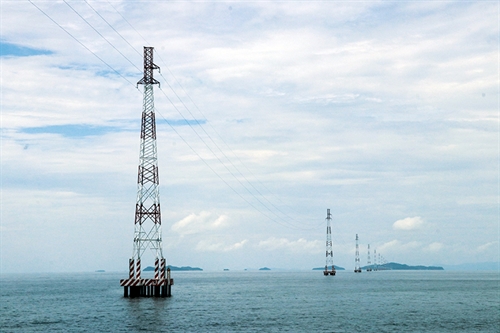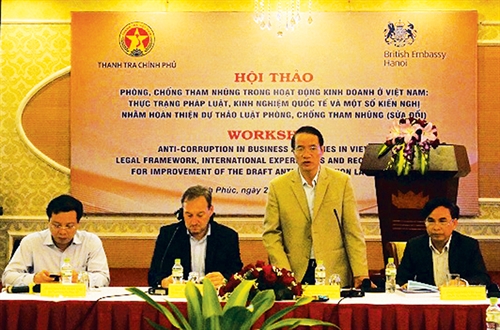From January 1 next year, the 2019 Law on Public Investment (the 2019 Law) will supersede its predecessor enacted in 2014 and revised in 2018 (the 2014 Law).
Consisting of six chapters with 101 articles, the 2019 Law provides the state management of public investment and the management and use of public investment funds. It also defines the rights, obligations and responsibilities of agencies, units, organizations and individuals involved in public investment activities.
The 2019 Law, with a series of new provisions, creates a sound legal framework for the Government to conduct public investment.
 |
| Overhead power lines transmit electricity to Hai Tac island, Tien Hai commune, Ha Tien city, Kien Giang province__Photo: Le Huy Hai/VNA |
Public investment funds and public investment objects
To be consistent with the Law on the State Budget, Article 4.22 of the 2019 Law changes the definition on public investment fund. Specifically, public investment funds include funds from the state budget and lawful revenues of state agencies and public non-business units reserved for investment. Compared to the 2014 Law, this definition has been narrowed. Under the 2014 Law, public investment funds include funds from the state budget, funds from national and government bonds and municipal bonds, official development assistance (ODA) loans and concessional loans of foreign donors, state development investment credit, revenues retained for investment but not yet included in state budget funds, and other loans from local budgets for investment.
A noteworthy new point of the 2019 Law is the provision on public investment objects, which have not been introduced in the 2014 Law. Under Article 5, there are six public investment objects below:
(1) Investment in socio-economic infrastructure programs and projects;
(2) Investment to serve activities of state agencies, non-business units, political organizations and socio-political organizations;
(3) Investment in and support for the provision of public utility and social welfare products and services;
(4) State investment in projects to be implemented in the form of public-private partnership;
(5) Investment to serve the formulation and appraisal of and decision on or approval, announcement and adjustment of master plans; and,
(6) Allocation of preferential loan interest rate subsidies and management expenses; allocation of charter capital for policy banks and off-budget state financial funds; and investment support for other policy beneficiaries in accordance with the Prime Minister’s decisions.
Noticeably, Article 5.1 states that in case of real necessity, the separation of compensation, support, resettlement and ground clearance contents into an independent project may be decided by the National Assembly, for national important projects, or by the Prime Minister or provincial-level People’s Councils, for group-A projects. The separation will be effected when such a project’s investment policy is approved.
Conditions for decision on investment policy on programs and projects
Under Article 18 of the 2019 Law, a program or project will have its investment policy decided when satisfying the following conditions: (i) conforming to the decided or approved socio-economic development strategy and plan and related master plans; (ii) not overlapping with another program or project for which investment policy decision or investment decision has been issued; (iii) having the required funds within the capability of balancing public investment sources and capability of raising other funds, for programs or projects using different funding sources; (iv) having the required funds within the capability of borrowing and repaying public, government and municipal loans; and (v) ensuring socio-economic effectiveness, national defense and security and sustainable development.
The 2019 Law adds tasks and projects not subject to investment policy decision, including investment preparation tasks, planning tasks, urgent public investment projects, projects under national target programs, and component projects under projects on which investment policy has been decided by competent authorities.
Investment policy decision for programs or projects funded by ODA loans or concessional loans of foreign donors
The order and procedures for decision on investment policy on a program or project funded by ODA loans or concessional loans of foreign donors is provided in Article 25 of the 2019 Law.
In addition to investment policy decision, such a program or project must also have its proposal approved according to law-prescribed procedures. Specifically, ministries, central agencies and localities will make program or project proposals for submission to the Ministry of Planning and Investment, Ministry of Finance and related agencies. The Ministry of Finance will take responsibility for determining preferential elements, assessing impacts of ODA loans or concessional loans of foreign donors on public debt safety criteria and determining domestic financial mechanisms in accordance with the Law on Public Debt Management. Based on opinions of related ministries, central agencies and localities, the Ministry of Planning and Investment will assess the necessity of the program or project, preliminarily evaluate the feasibility and socio-economic effectiveness of, and environmental impacts (if any) and impacts of the program or project on the medium-term public investment plan, and select appropriate program or project proposals for submission to the Prime Minister for consideration and decision.
Particularly, project proposals are not required for programs and projects funded by non-refundable ODA aid not accompanied with loans.
The national information system and database on public investment
Under Article 97 of the 2019 Law, the national information system and database on public investment will be uniformly developed and operated nationwide to serve the state management of public investment, including the summarization, reporting, assignment, and adjustment of medium-term and annual public investment plans, monitoring and evaluation of public investment programs and projects; and data management, storage and disclosure under regulations.
Information and data of the national information system and database on public investment are original information and data of public investment programs, projects and plans.
The Ministry of Planning and Investment is assigned to organize the formulation, management and operation of the national information system and database on public investment. Meanwhile, ministries, central agencies and localities will, within the scope of their management, organize the application of the national information system and database on public investment.
To ensure the implementation of public investment programs and projects, the 2019 Law has transitional provisions. For programs and projects for which funds are included in investment plans and the investment in which is decided before January 1, 2015, but for which funds have not yet been included in the 2016-20 medium-term public investment plans, the adjustment of investment decisions for such programs and projects must comply with the 2019 Law.
For programs and projects for which investment policy decisions or investment decisions have been issued under the 2014 Law, without being included in public investment plans decided by competent authorities, the adjustment of such decisions must comply with the 2019 Law.
For programs and projects for which the formulation and appraisal procedures are completed before the effective date of the 2019 Law, they will still be submitted to competent authorities for consideration and decision under the 2014 Law.
Noticeably, funds under public investment plans will only be allocated to pay outstanding debts in capital construction arising before January 1, 2015. For public investment fund plans for 2019 and 2020, ministries, central agencies and localities may perform them and disburse funds under the 2014 Law.-









